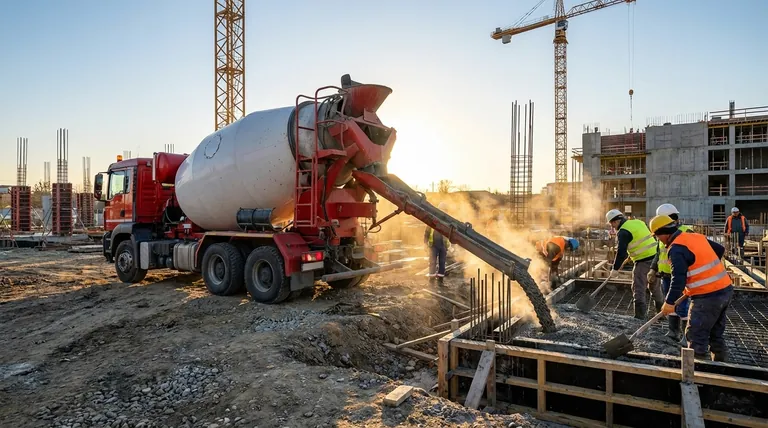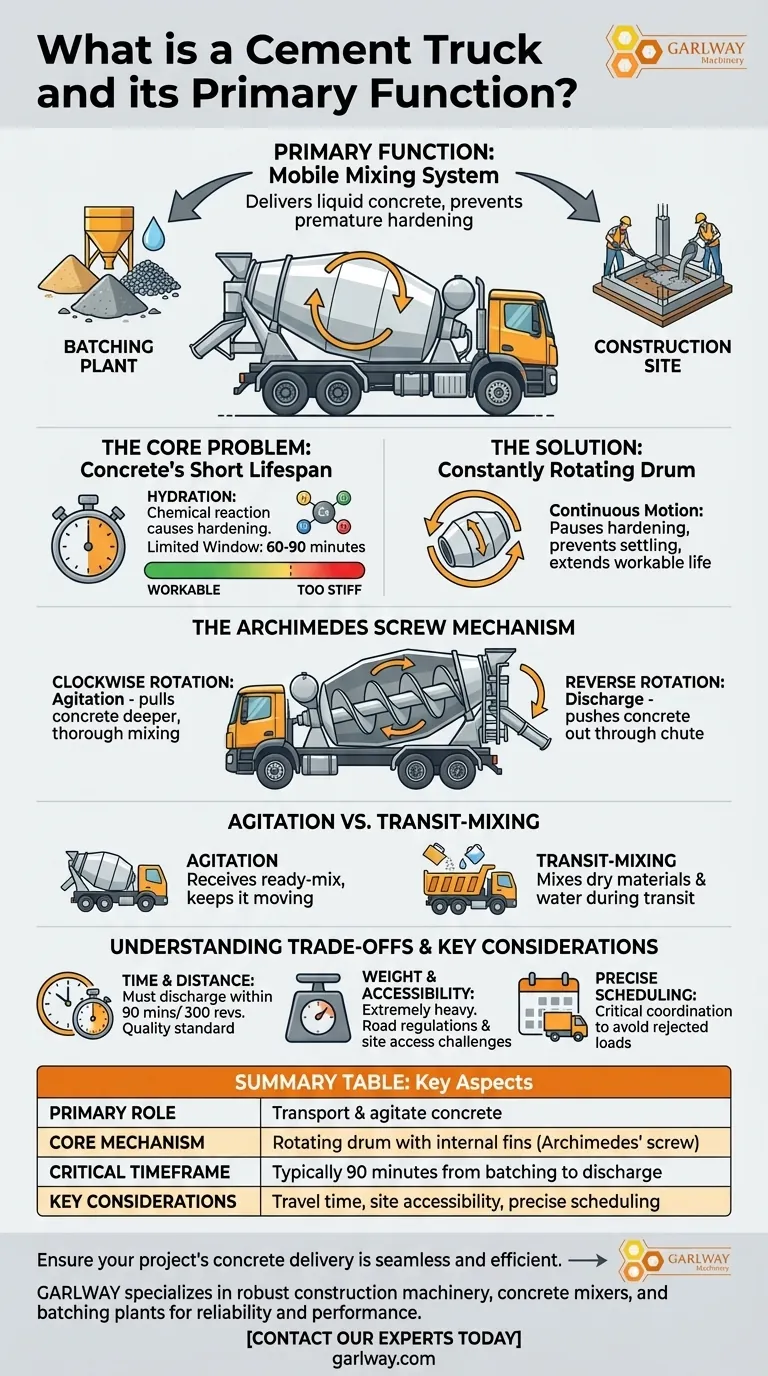At its core, a cement truck is a specialized transport vehicle designed for a single, critical purpose: to deliver concrete from a batching plant to a construction site while keeping it in a liquid, unhardened state. Often called a concrete mixer, its defining feature is a large, rotating drum that constantly agitates the mixture to prevent it from solidifying prematurely.
The true function of a cement truck is not just transportation. It is a mobile mixing system that solves the fundamental problem of concrete's limited working time, ensuring the material is viable and ready to be poured upon arrival.

The Core Problem: Concrete's Short Lifespan
To understand the design of a cement truck, you must first understand the nature of concrete itself.
The Chemical Reaction of Hydration
When cement and water are mixed, a chemical reaction called hydration begins. This process is what causes the concrete to harden and gain strength.
The Race Against the Clock
Hydration is irreversible. Once it starts, there is a limited window of time—typically 60 to 90 minutes—before the concrete becomes too stiff to pour and work with.
How a Cement Truck Solves This Problem
The entire design of the vehicle is a direct solution to the time-sensitive nature of concrete.
The Constantly Rotating Drum
The most vital component is the rotating drum. By keeping the concrete in continuous motion, the truck prevents the heavy aggregates (like sand and gravel) from settling and disrupts the initial bonds forming during hydration.
This constant agitation, or mixing, effectively pauses the hardening process, extending the material's workable life long enough to reach the job site.
The Archimedes Screw Mechanism
Inside the drum are helical blades, often called fins, that follow an Archimedes' screw principle.
When the drum rotates in one direction (typically clockwise), the blades pull the concrete deeper into the mixer, ensuring a thorough agitation. When the drum's rotation is reversed, these same blades push the concrete out through the delivery chute.
Agitation vs. Transit-Mixing
A cement truck can perform one of two functions. It can receive a fully prepared batch of "ready-mix" concrete and simply agitate it during transport.
Alternatively, dry materials and water can be loaded separately and mixed together inside the drum during transit. This is known as transit-mixing.
Understanding the Trade-offs
While indispensable, these vehicles have operational limitations that must be factored into any construction plan.
Time and Distance Constraints
Even with constant mixing, the hydration process continues. A truck must typically discharge its entire load within 90 minutes and before the drum has completed 300 revolutions to ensure the concrete meets quality and strength standards.
Weight and Accessibility
Fully loaded, a cement truck is exceptionally heavy, placing it under strict road weight regulations. Its size and weight can also pose significant challenges for accessing tight or undeveloped construction sites with soft ground.
Precise Scheduling is Critical
Because the clock is always ticking, the dispatch of a cement truck from the plant and its arrival on-site must be meticulously coordinated. Delays on the road or at the site can easily lead to a rejected load of hardened, unusable concrete.
Making the Right Choice for Your Goal
Understanding the vehicle's function is key to managing any project involving concrete.
- If your primary focus is material quality: Ensure the travel time from the batch plant to your site is well within the 90-minute window to guarantee the concrete's structural integrity.
- If your primary focus is project efficiency: Coordinate truck arrivals precisely with your on-site crew's readiness to pour, preventing costly delays and wasted material.
- If your primary focus is site logistics: Confirm that all access roads and the designated pouring area can safely support the immense weight and dimensions of a fully loaded truck.
Ultimately, viewing the cement truck as a critical piece of time-sensitive equipment is essential for successful concrete work.
Summary Table:
| Key Aspect | Function |
|---|---|
| Primary Role | Transport & agitate concrete to prevent premature hardening |
| Core Mechanism | Rotating drum with internal fins (Archimedes' screw) |
| Critical Timeframe | Typically 90 minutes from batching to discharge |
| Key Considerations | Travel time, site accessibility, precise scheduling |
Ensure your project's concrete delivery is seamless and efficient.
GARLWAY specializes in providing robust construction machinery, including concrete mixers and batching plants, for construction companies and contractors globally. Our equipment is designed for reliability and performance, helping you meet tight deadlines and maintain material quality.
Contact our experts today to discuss the right concrete solutions for your specific site requirements and project goals.
Visual Guide

Related Products
- Portable Concrete Mixer Machine Equipment for Mixing Concrete
- HZS35 Small Cement Concrete Mixing Batch Plant
- Hydraulic Concrete Mixer Machine Cement Mixing Equipment for Mixture Concrete
- HZS25 Best Cement Mixer for Quick Mix Concrete at Bunnings
- Concrete Cement Mixer Machine Drum Mixer for Construction
People Also Ask
- What are the factors influencing choice of a concrete mixing plant? Key Considerations for Efficiency
- How long does it take to mix concrete in a portable mixer? Master the 60-Minute Rule
- How much does a batching plant cost? Uncover the True Investment for Your Project
- How much concrete can you mix in a portable mixer? Maximize Efficiency on Small Jobs
- How much does a portable concrete mixer hold? A Guide to Choosing the Right Capacity



















